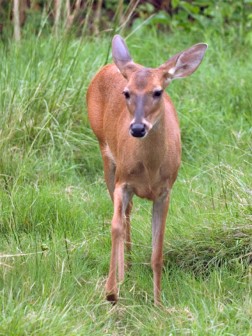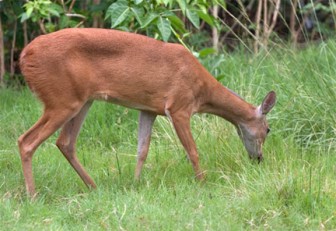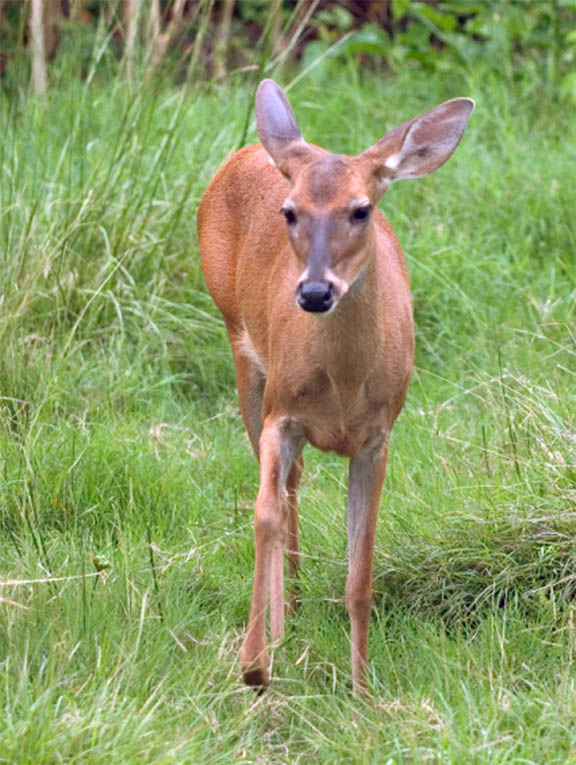(Savannah Deer)
Odocoileus virginianus, locally known as White-tailed or Savannah Deer, has a large range from southern Canada to northern South America; obviously they can survive in a wide variety of habitats including forest, grasslands, savannah, farming and urban areas.
Savannah Deer are medium size deer with short ears, long tail with white underneath. There is white around the eyes, a white band across the nose, white edging the ears and chin and the upper reaches of the legs. They have a reddish brown coat which changes with the season, becoming a greyish brown during the winter in northern countries. The male and female can be told apart as only the males grow antlers which they drop after the mating season. In the North Rupununi, it has been said that the males start to grow their antlers at the end of the rainy season and the males go into the bush islands in the savannah to look for trees where they scratch the nodes of the new antler growth.
Savannah Deer are herbivorous (vegetarians); the stomach of a deer is similar to that of a cow, and allows them to browse on a wide variety of plant material including leaves, twigs, fruits, nuts, lichen and other fungi. When browsing they will feed until their first stomach is filled and then find a safe location to chew their cud and fully digest their meal. Savannah Deer are mainly nocturnal or crepuscular, browsing and drinking water mainly at dawn and dusk, looking for water before bedding down and after first awaking.
For the most part, Savannah Deer are solitary but will form small groups, usually consisting of females and their litter or a few males. In the northern ranges of Canada and the USA, they often congregate during the winter season into large groups of over 100 individuals for protection from predators as well as mating.
Females usually come into estrus at two years old and gestation is approximately 7 months, while birthing occurs between May and June. Females will birth 1 to 3 young which are reddish and white spotted; the fawns are born scentless so that predators are less likely to find them when their mother leaves them to forage. The fawn walks at birth and will start grazing a few days after, and the white spots are lost within the first year.

Savannah Deer have excellent eyesight and hearing but they depend on their sense of smell to alert them to danger and to escape; they can run at speeds of up to 40 mph. In Guyana, they are preyed on by jaguars, pumas and humans. In North America, their primary predators are pumas and wolves, and unfortunately, the population of these top predators has been reduced as a result of hunting and habitat destruction. As there are no natural predators for deer in Canada and the US, and because they use so many diverse habitat areas, the population of deer has exploded and they have become pests in farming and urban areas, and their population is now controlled through strictly managed seasonal hunting.
As a result, internationally, deer are listed by CITES as “least concern”; however in Guyana the population of deer may be reducing as a result of overhunting, but more research needs to be conducted to confirm this.
Rain forests are rich in biodiversity and are home to many different plants and animals as well as indigenous communities. Humans, even those who don’t live in the rain forest, rely on it for resources such as building materials (wood and lianas), medicine and fruits.
Rain forests are rich in biodiversity and are home to many different plants and animals as well as indigenous communities.
Humans, even those who don’t live in the rain forest, rely on it for resources such as building materials (wood and lianas), medicine and fruits.
Rain forests also provide essential environmental services for life on earth; they create soil as well as prevent soil erosion, produce oxygen through photosynthesis, maintain clean water systems, and are a key defence against climate change.
The Iwokrama Rain Forest is 371,000 hectares, located in the heart of Guyana. Our mission is to develop strategies for conservation and sustainable development for local people in Guyana and the world at large.
We are involved in timber, tourism and training. Come and visit us in the rain forest or at http://www .iwokrama.org.

(Photo by G Veld)

